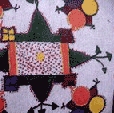Delicate brass filigree wires are intricately wound to make products that are given a gold or silver coating to enhance their appeal. The brass filigree craft originated with the use of coral and turquoise stones that were combined with intricate filigree work to make jewellery. Gradually, this work was extended into the crafting of other products, including pillboxes and larger containers. Nowadays, along with traditional items, very fine and delicate Christmas tree ornaments are being made for the export market. Other decorative items such as birds and animals are also being hand-crafted in the same style.
PROCESS & TECHNIQUE
A time-tested technique is used. The artisan works with a brass sheet of the required thickness. To make wires the metal sheet is cut with shears. The roughly cut strips are then pulled with draw-tongs through draw-plates bearing holes in graduated sizes. The wires produced are then used to fashion the required products. Two or three wires are wound together after heating and then bent into various shapes to create patterns. The components are fixed together by a special method.

For the silver filigree, traditionally, the ingots are beaten on an anvil and elongated into long wires by passing them through a steel plate with apertures of different wire gauges. Each filigree jewellery piece actually combines several component parts. The space within the frame is filled with the main ribs of the pattern, which is usually a creeper or flower, forming itself into small frames of circles, flower petals, and the like.
PRODUCTS
This traditional craft requires delicate workmanship. Besides jewellery, ash-trays, boxes, and cigarette cases are also made. Decorative items such as birds and animals are hand-crafted, as are very fine and delicate Christmas tree ornaments. These are being made for the export market.
PRACTITIONERS
The shakya families of Lalitpur are engaged in this production. Women who work within their homes craft these products.

